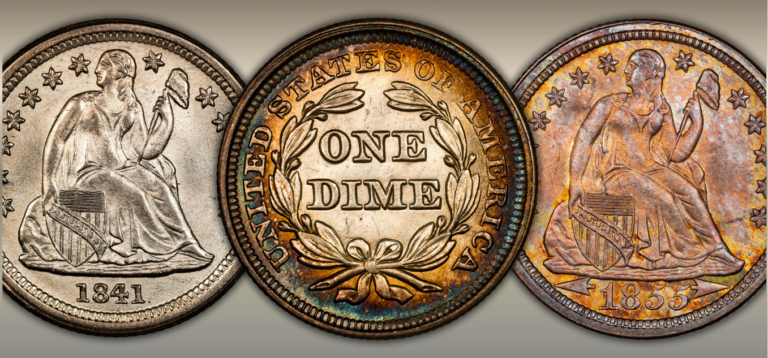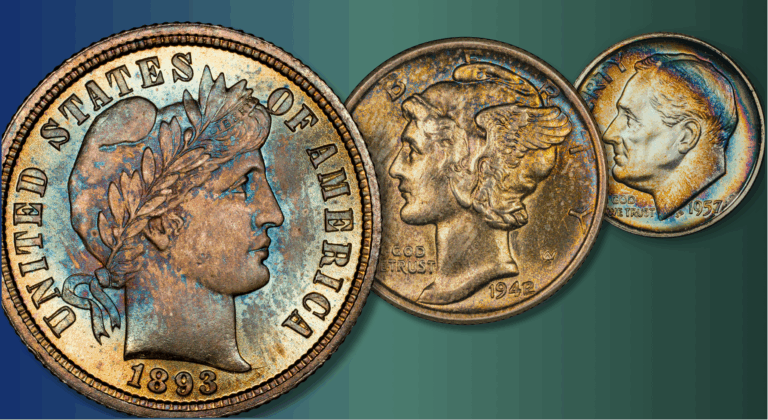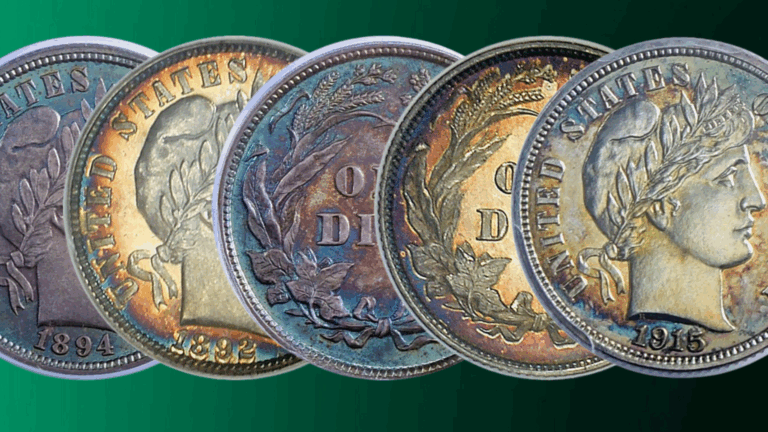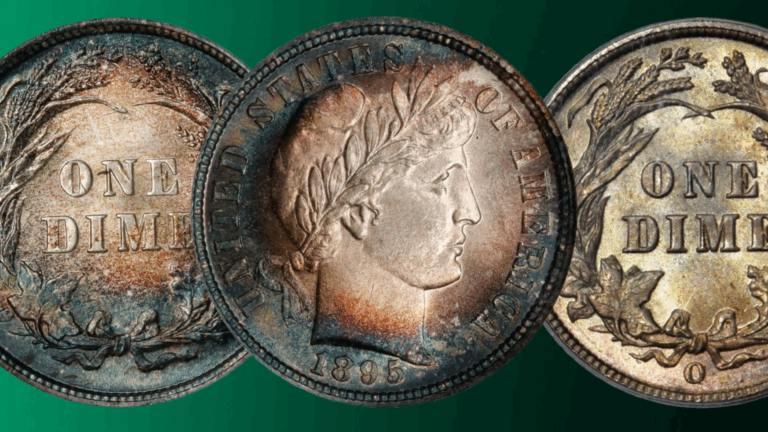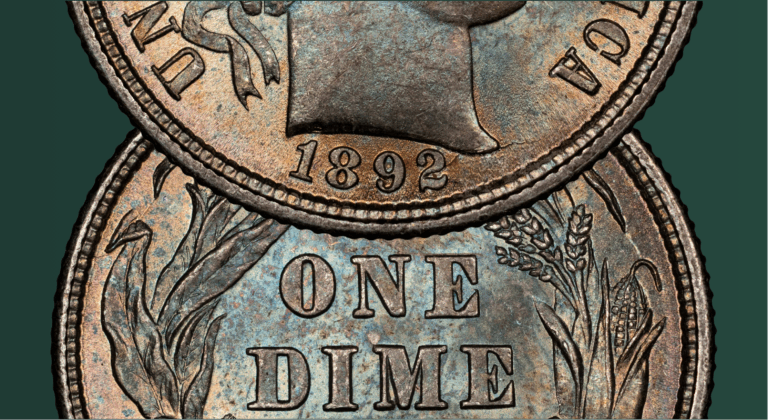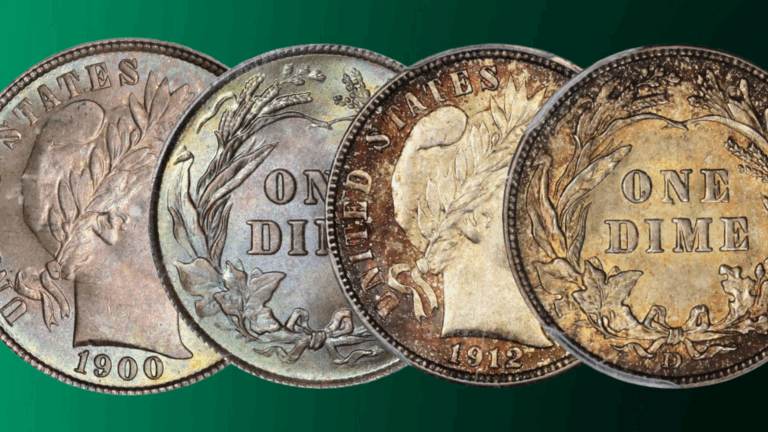by Greg Reynolds
This is an installment in my series on assembling a set ‘by date’ of Liberty Seated half dollars in Very Fine to Almost Uncirculated grades (VF-20 to AU-55). Here, ‘With Motto’ Liberty Seated halves minted from 1866 to 1873 are covered.
In 1866, the motto, ‘In God We Trust,’ was added to quarters, half dollars, silver dollars, half eagles, eagles, and double eagles. In 1873, new types were created by the adding of arrows to the obverse (front) designs of dimes, quarters, and half dollars. The present discussion is about half dollars dating from 1866 to 1873 that were coined in accordance with the Coinage Act of 1853. The coinage law passed in 1873 is a different matter.
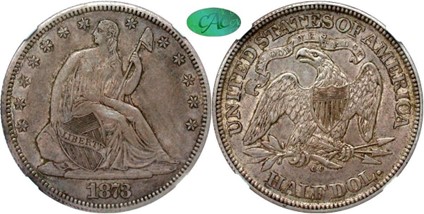
The Use of Paper Money due to Silver Shortages
As was explained in previous installments in this series, and in other pieces that I contributed to this site, during the early 1850s, U.S. silver coins were rarely spent because the value of their silver content was greater than their respective face values. The Coinage Act of 1853 reduced the silver content of half dimes, dimes, quarters, and half dollars such that it became economically beneficial for consumers to spend them rather than hoard, export or melt them.
By 1862, market conditions and political factors were such that both pre-1853 and post-1853 U.S. silver coins rarely circulated in the Eastern United States or the Midwest. Except in the West, almost all U.S. silver coins were saved, hoarded, or exported.
The role of paper money in the economy had become complicated with the introduction of federal fractional currency, which were paper notes denominated below $1, and ‘greenbacks,’ which were the first type of federal government paper money of regular denominations for general circulation. Also, there was much economic uncertainty after the U.S. Civil War ended in 1865. People were fearful of the future and distrustful of government monetary policies.
As historian R. W. Julian has emphasized, there was a sharp difference in spending patterns among people who lived east of the Rocky Mountains and those who resided in the West. The vast majority of the U.S. population lived east of the Rocky Mountains. U.S. government issued paper money, notes issued by local governments, privately issued paper money and store coupons, copper and copper-nickel coins, tokens, plus other items were used for purchases effected in the United States from the early 1860s to the late 1870s. The West, however, was an exception.
Many people on the West Coast were suspicious of all forms of paper money, checks and coupons. Westerners tended to favor the use of silver or gold for purchases of goods and services, even in cases where substantial transaction costs were incurred by using silver coins or gold coins. Most merchants in California refused to accept paper money or notes of any sort. The cultural and political environment in the West encouraged the use of silver and gold coins and discouraged the use of paper money, related notes, checks or store coupons in transactions.
On the East Coast, from 1862 to some point in the 1870s, people became accustomed to using paper to buy goods and services, though paper money was discounted in relation to amounts figured in silver or gold dollars. For example, if an item was priced at $10 in gold, the seller would probably demand more than $10 in U.S. paper money for it. In those days, prices were negotiable to a greater extent than they are currently, and different varieties of money in the U.S. had different values.
Pre-1853 silver coins, post-1853 silver coins, U.S. paper money, local paper money, privately issued paper instruments, and U.S. gold coins were all denominated in U.S. dollars yet varied in value at any one point in time. Put differently, $10 worth of pre-1853 silver coins, $10 worth of silver coins struck after the Coinage Act of 1853 was implemented, $10 worth of U.S. gold coins, a $10 banknote, and a $10 greenback (U.S. government paper money) all had different values in marketplaces, and these values changed over time.
“This gold value of silver was, throughout most of 1862, about 97 cents per dollar, and the greenbacks [U.S. government paper money] fell below that [97¢] figure in June 1862 and remained below it for many years thereafter,” states Neil Carothers in his landmark book, Fractional Money (NY: John Wiley, 1930, p. 214).
Mostly because of the widespread use of paper money including U.S. 50¢ notes, mintages of half dollars in Philadelphia from 1866 to 1870 were not large. During that time period, a mintage of one million was large, though it should be taken into consideration that the New Orleans Mint did not produce any Liberty Seated half dollars after 1861.
The Minting of Half Dollars from 1862 to 1873
The Philadelphia and San Francisco Mints were the only facilities producing U.S. half dollars from 1862 to 1869. The Carson City (CC), Nevada Mint began doing so in 1870.
In 1867 and 1868, the San Francisco Mint produced more than twice as many half dollars as the Philadelphia Mint did, although only a small percentage of U.S. citizens lived in the West during the nineteenth century. In 1871, the San Francisco Mint struck more than two million half dollars, by far the highest output of half dollars by any mint since 1861. That same year, more than 1.2 million halves were minted in Philadelphia, the highest number there since 1861.
More than 150,000 1871-CC halves were struck. Although 150k was small in the context of mintages of half dollars in Philadelphia and San Francisco, the total mintage of all three mints in 1871, more than 3.5 million, was very large for an annual total for a silver denomination from 1862 to 1873.
As U.S. silver coins were not circulating in the Eastern United States from 1866 to 1873, why was the Philadelphia Mint producing them? U.S. silver coins were often kept in the U.S. as personal savings. It follows logically that banks and other businesses kept half dollars as reserves, especially since silver dollars traded for prices well above $1 each. Each silver dollar contained more silver than did two half dollars or four quarters; unlike other Liberty Seated denominations, the silver content of silver dollars was not reduced in 1853 in response to market realities and thus U.S. silver dollars became more like bullion items than coins during the 1850s, 1860s, and early 1870s.
Importantly, a large percentage of Philadelphia Mint half dollars dating from 1863 to 1873 left the United States soon after they were minted. “Silver coins were exported for a variety of reasons. Some of them were purchased by the wealthy in Central & South America as a hedge against inflation or revolution. In other cases, our coins were used in the marketplaces in Canada and Latin America,” reveals eminent historian R. W. Julian on Oct. 13, 2022, in response to my inquiries.
Fortunately for collectors in 2023, the fact that half dollars from the 1860s and 1870s were saved contributed to the reality that a significant number of them have been available for collectors to acquire. Many of those exported to Latin America from 1866 to 1873 later returned to the United States.
Indeed, half dollars minted from 1866 to early 1873 are not extremely rare. Most dates are mildly rare, and are relatively good values for collectors, from a logical perspective. Since 2009, especially since the middle of 2015, rare Liberty Seated coins have been overshadowed by rarities in other series of classic U.S. coins and by superb quality Liberty Seated coins that are not particularly rare overall.
Superb quality coins are often sought by collectors assembling type sets or connoisseurs who enjoy viewing them. It is much more difficult to collect Liberty Seated coins by date than it is to assemble any kind of type set of coins minted after the U.S. Civil War (1861-65). Certainly, it is challenging to complete a set or subset of Liberty Seated halves by date that is entirely or almost entirely composed of CAC certified coins.
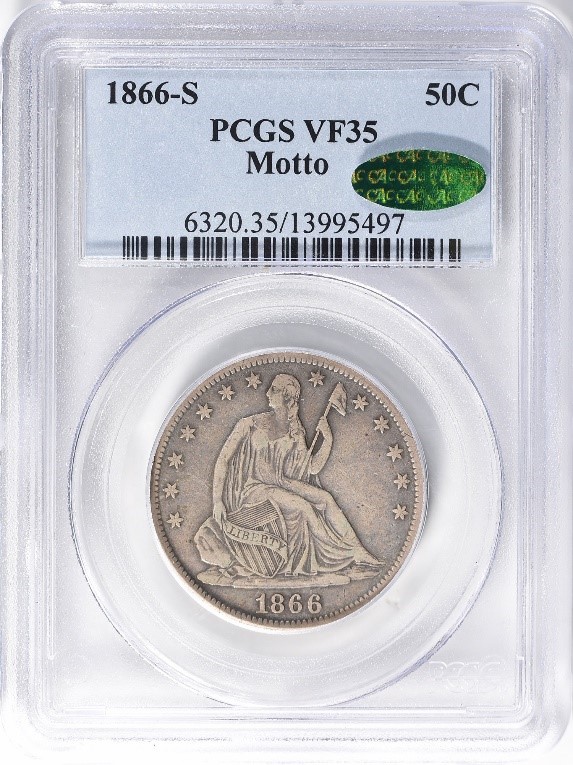

Show off Your Collection in the CAC Registry!
Have CAC coins of your own? If so, check out the CAC Registry–the free online platform to track your coin inventory, showcase your coins by building public sets, and compete with like-minded collectors!
CAC Approved 1860s Half Dollars from VF to AU
In theory, a CAC approved Very Fine grade 1866 half would retail for an amount between $100 and $200. In reality, however, it might be very difficult to find one.
It is a realistic possibility that, after CAC expands operations in 2023, a substantial number of uncertified coins that are worth between $75 and $400 each will be submitted to the new CAC office in Virginia for grading and encapsulation. Before 2023, for a coin to be CAC approved, it had to be first submitted to PCGS or NGC and then later submitted to CAC. Grading fees and shipping charges were incurred in regard to submissions to two different services. At some point in 2023, uncertified coins may be submitted to CAC.
Overall, there are fewer 1866-San Francisco halves approved by CAC than 1866 Philadelphia Mint halves. In grades below XF-40, however, more 1866-S half dollars are CAC approved than 1866 Philadelphia Mint halves.
Back on February 23, 2020, GreatCollections sold a CAC approved VF-35 grade 1866-S for $206.78. As of Thanksgiving 2022, the current CPG-CAC retail price estimate for that coin is $265.
Like 1866 halves, 1867 half dollars are rare though not very rare. Well circulated coins are around, though were not usually sent to CAC in the past. In August 2020, Gerry Fortin’s firm (GFRC) sold a CAC approved XF-40 grade 1867 for $450.
In January 2021, Gerry Fortin auctioned a CAC approved XF-40 grade 1867-S for $485. Back in September 2019, David Lawrence Rare Coins sold a CAC approved VF-35 grade 1867-S for $230.
It may be even more difficult to find a CAC approved, VF-20 to AU-53 grade 1868 than a similarly certified 1867 or 1867-S half dollar. As of Thanksgiving 2022, CAC has approved just twenty-two in all grades, though, again, there is a good chance that CAC populations of circulated classic U.S. silver coins will increase in the future after the CAC office in Virginia becomes fully operational.
The 1869-S and 1870 Liberty Seated Half Dollar
In August 2020, Gerry Fortin’s firm sold a CAC approved, PCGS graded XF-40 1868 half for $525. On Sept. 11, 2022, GreatCollections sold a CAC approved, NGC graded XF-45 1868-S for $459.
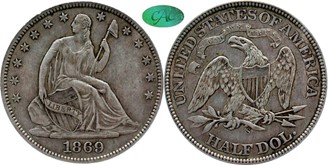
The 1869 and the 1869-S are in the same category of scarcity as the 1867 and 1867-S. In March 2020, Gerry Fortin sold a CAC approved XF-45 grade 1869 for $325, which is almost exactly the current CPG-CAC retail price estimate, $328. Gerry Fortin sold a CAC approved PCGS graded XF-45 1869-S for $625 in January 2021 and the same coin again for $650 in May 2022.
In January 2022, Fortin sold a CAC approved AU-50 grade 1870 for $535. Over time, collectors should be able to find CAC approved VF to XF grade 1870 halves for prices in the range of $100 to $300.
Although one million 1870-S halves were minted, these are mildly rare in the present. PCGS and NGC reports include multiple counts of some of the same individual coins.
Even so, this is an exciting date because other 1870-S coins are so important. The 1870-S half dime is unique. Only one 1870-S Three Dollar gold piece is known to exist, the Eliasberg-Bass coin. Both the 1870-S half dime and the 1870-S Three will be auctioned in January 2023.
In July 2021, Gerry Fortin sold a CAC approved, PCGS graded XF-40 1870-S half dollar for $575. If there was a CAC approved VF-20 grade 1870-S, it would have a medium retail value of around $210 in late 2022 and early 2023.
In regard to coins of similar quality, the 1870-CC is much more valuable than the 1870-S. I estimate that 175 1870-CC half dollars survive. Quite a few of these, however, have problems that preclude or should preclude the assignment of numerical grades.
Carson City Mint coins are much more popular with collectors than Liberty Seated coins from other mints. Indeed, the number of people who collect Carson City Mint silver coins overall ‘by date’ is greater than the number of people who collect any one denomination of Liberty Seated coins of all mints ‘by date.’
In August 2021, Heritage auctioned a CAC approved, VF-35 grade 1870-CC half for $12,000. Back in August 2015, Stack’s Bowers auctioned a CAC approved VG-08 grade 1870-CC for $2820.
The 1871-S Liberty Seated Half Dollar
The 1871 Philadelphia Mint issue and the 1871-S distinguish themselves from other halves dating from 1866 to 1873 by not being rare. I theorize that more than five hundred of each survive, though not many more, perhaps less than 570 of each.
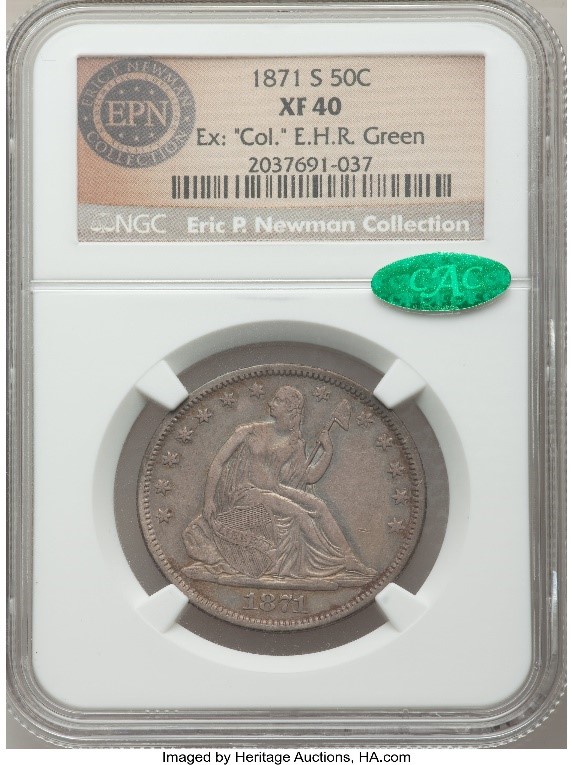
CAC reports thirty-six 1871 halves and forty-four 1871-S halves. I suggest that interested collectors submit some 1871 and 1871-S halves to CAC, coins that have been carefully selected.
Gerry Fortin sold a CAC approved AU-55 grade 1871 for $575 in January 2021 and a CAC approved AU-50 1871 for $385 in August 2020. If there was a CAC approved VG to Fine grade 1871, it would probably have a retail value below $105, during 2023.
Back in February 2018, David Lawrence Rare Coins sold a CAC approved PCGS graded VF-35 1871-S for $110. Heritage twice sold a CAC approved, NGC graded XF-40 1871-S that was earlier in the famous collection of Eric Newman. On May 25, 2021, it realized $252. On Nov. 16, 2013, while it was very fresh and market levels were higher, this same 1871-S in the same special Newman Collection NGC holder, realized $440.63.
The 1871-CC is rare, but not very rare. In contrast to Philadelphia Mint Liberty Seated half dollars, much of the value of the 1871-CC half stems from the overall popularity of Carson City Mint coins.
For 1871-CC halves, some of the reported prices realized in public sales are very much inconsistent with leading price guides. Probable reasons are difficult to explain. I suggest that each interested collector consult an expert before acquiring an 1871-CC half.

The 1872 Liberty Seated Half Dollar
CAC approved 1872 halves are around, though a collector may have to wait a little while to acquire one. In July 2020, Gerry Fortin sold a CAC approved XF-40 1872 for $250. During the next month, Fortin sold a CAC approved AU-50 1872 for $350, he reports. In March 2020, Heritage sold a CAC approved AU-55 1872 for $456. If CAC had approved a VF grade 1872, a medium level retail price for it in 2023 would probably be less than $155.
I estimate that fewer than 285 1872-S halves survive, rare for sure. Perhaps at least eighty of these are ungradable or should not have been assigned numerical grades, in my opinion. So far, CAC has approved just twenty, with zero 1872-S halves grading below VF-35. If more in the Good-04 to VF-30 grade range are submitted to CAC in the future, the CAC pop for this date could markedly increase. In the past, I have seen more than a few, well circulated 1872-S halves that I maintain will qualify for numerical grades if submitted to the new CAC office in Virginia after it opens for regular business.
Back in 2018, Heritage sold a CAC approved VF-35 grade 1872-S half for $396. Though this result is notably higher than estimates now listed in pertinent price guides, I maintain that $396 is currently a low to medium level retail price.
In circulated grades, the 1872-CC is not nearly as scarce as the 1871-CC half dollar. On Gerry Fortin’s website, he says that his firm sold a CAC approved VF-35 grade 1872-CC for $3000 in November 2021 and a CAC approved XF-40 grade 1872-CC for $3862 in January 2021. Both these results were very strong.
In many cases, I copy prices realized from the websites of widely recognized sellers. While I believe such prices realized to be accurate, mistakes by sellers or typographical errors on my part may possibly occur.
The public sale results that are listed in my articles on the CAC site have not been verified by CAC. For multiple reasons, each collector is advised to pose questions to experts and to seek a consultation about collecting strategies before spending a substantial sum of moneys.
The Coinage Act of 1873 and the Values of an 1873 Half Dollar
The values of 1873 half dollars require an explanation. The Coinage Act of 1873 led to arrows being added to the obverse designs of dimes, quarters, and half dollars. The act, however, did not take effect until April 1. Half dollars struck earlier in 1873 need not have arrows. Those were thus part of the ‘With Motto, No Arrows’ (1866-73, 1875-91) design type of half dollars.
The 1873 ‘Open 3’ and ‘Close 3’ are major varieties that are generally collected as if they are two distinct dates from the Philadelphia mint during the same year. The ‘Open 3’ is not actually open; the upper and lower parts of the numeral three at the left are relatively far apart. In other words, there is a noteworthy distance between the knobs. On the ‘Close 3’ coins, the knobs are relatively close together.
Gerry Fortin reports that his firm sold a CAC approved AU-53 grade 1873 ‘Close 3’ half dollar for $795 in August 2020. As of Thanksgiving 2022, the CPG-CAC medium retail estimate for this coin was $484. Back on Dec. 31, 2019, Heritage sold a CAC approved XF-45 grade 1873 ‘Close 3’ half for $198.
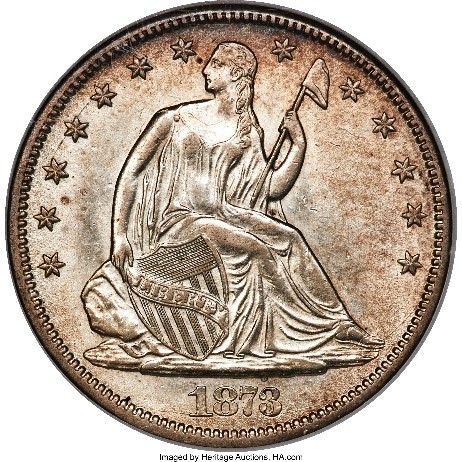
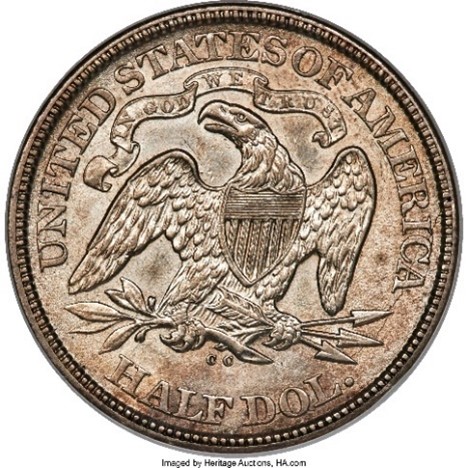
The CAC population of 1873 Open 3 — ‘With Motto, No Arrows’ half dollars is just eleven. Non-CAC coins of this date, however, are not hard to find. I suggest consulting an expert about them.
All 1873-CC ‘No Arrows’ halves are of the ‘Close 3’ variety. Though rarer than 1871-CC and 1872-CC halves, these are much less rare than would have been expected, given the fact that ‘Arrows’ were required on all halves struck after March 31, 1873. Moreover, before 1875, the mintages of Carson City half dollars were rather low. The mintage of 1873-CC No Arrows halves, 122.5k, is less than half the mintage of 1872-CC halves, 257k, and, of course, significantly less than the mintage of 1873-CC ‘With Arrows’ halves, about 215k, which will be discussed in the next installment.
As of Thanksgiving 2022, CAC lists thirty-three 1873-CC ‘No Arrows’ though few of these have sold publicly over the last dozen years. On Oct. 6, 2022, Heritage sold a CAC approved, NGC graded AU-55 1873-CC ‘No Arrows’ half for $9300. In March 2018, Gerry Fortin sold a different CAC approved, NGC graded AU-55 1873-CC ‘No Arrows’ half for $9500. The CPG-CAC medium retail value estimate for a CAC approved VF-30 grade 1873-CC ‘No Arrows’ half is $3150.
It would not be really easy to complete a CAC-only run of VF-20 to AU-55 grade, post-Civil War, ‘With Motto, No Arrows’ half dollars, those dating from 1866 to 1873. This, though, is a realistic objective. An easier quest would be to complete this run while including one to three non-CAC coins, selected with expert advice, in an otherwise CAC-only group.
Images are copyrighted by GreatCollections.com, Gerry Fortin (seateddimevarieties.com) or Heritage Auctions (ha.com).
Copyright © 2022 Greg Reynolds
About the Author
Greg is a professional numismatist and researcher, having written more than 775 articles published in ten different publications relating to coins, patterns, and medals. He has won awards for analyses, interpretation of rarity, historical research, and critiques. In 2002 and again in 2023, Reynolds was the sole winner of the Numismatic Literary Guild (NLG) award for “Best All-Around Portfolio”.
Greg has carefully examined thousands of truly rare and conditionally rare classic U.S. coins, including a majority of the most famous rarities. He is also an expert in British coins. He is available for private consultations.
Email: Insightful10@gmail.com
